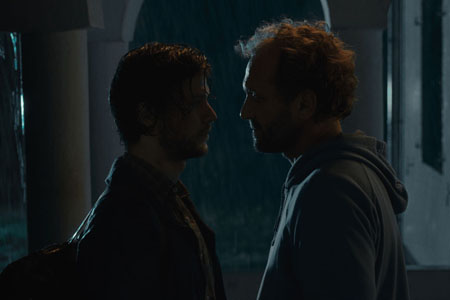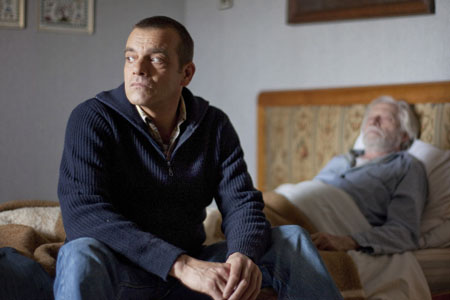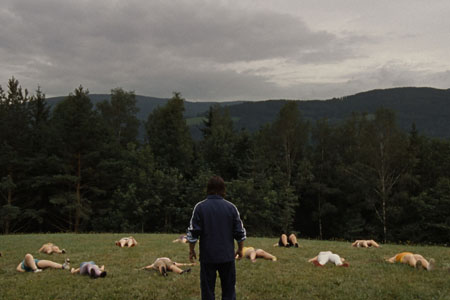I spent the second day of the Berlinale in the European countryside. In the morning, it was Poland, just a few hours drive away, out in an isolated village one of the characters in Malgoska Szumowska’s In the Name of (W imie…) calls a “shithole”—and sure enough, flies are constantly buzz-rushing and alighting on the troubled boys in a rehabilitation center run by the Catholic Church. To earn their keep, the boys shed their shirts and break boulders into rocks for construction material. On their time off, they play soccer, drink beer, and start fights with the locals. Adam (Andrzej Chyra, making the most of his Christ-like visage) is the priest and go-between: both the center and the town are his parish. He’s been transferred here from Warsaw, and Ewa (Maja Ostaszewska), a youngish woman bored out of her skull who tries and fails to seduce him, isn’t the only one, on screen or in the audience, wondering if that transfer isn’t some sort of punishment. And yes, Adam, who’s clearly the mentor these boys need as well as a balm to the village souls, does indeed harbor a dark secret.
Szumowska’s juxtaposition of handheld whiplash for one scene and then, say, a slow, steady zoom for another might suggest a confidence in her own range as well as in her own judgement when it comes to deciding when to plug in which style where. On the other hand, it might suggest that she’s unaware of how such radical shifts in visual tone threaten an audience’s engagement with a story so dependent on empathy with not just Adam but with a good handful of the boys as well. You can probably tell where my suspicions lie, and nothing suggests the latter more than a scene that yanks the entire film to a halt for what’s probably no more than three or four minutes but feels like ten. A song is played, full blast, and it is a very bad song. Worse, if I had to, I’d bet that Szumowska is playing that song sincerely. (I can’t find the name of the song or the band, and if anyone wants to help me out in the comments, I’d be grateful. Granted: A bad song does not necessarily make for a bad scene. As Mike D’Angelo will tell you, “To All the Girls I’ve Loved Before” is the backbone of a truly great scene in Maren Ade‘s Everyone Else; myself, I’d go on about Robbie Williams’s “Feel” in Valeska Grisebach’s Longing, but I’ve already digressed more than enough.)
More on In the Name of from Jonathan Romney (Screen), Alissa Simon (Variety) and Deborah Young (Hollywood Reporter). Update, 2/10: More from Bénédicte Prot at Cineuropa, where Fabien Lemercier interviews Szumowska.
Updates, 2/13: Stephen Garrett for Time Out New York: “A few moments are annoyingly maudlin and too on-the-nose—our hero, driven to drink because of his guilt, accidentally knocks down a framed picture of Pope Benedict XVI and then proceeds to dance around with him—but the missteps are few in what is otherwise an admirably empathetic portrait of divine pain.”
“Too much time is spent generating intrigue in the build-up to the revelation of Adam’s sexuality,” finds Giovanni Marchini Camia, dispatching to Film Comment, “and once it’s established, the film seems unsure how to treat the complexities of its themes, instead meandering to an affected finale that forsakes the subtlety that had so distinguished its first half.”
Update, 2/18: Here in Keyframe, Anna Tatarksa interviews Szumowska.
This afternoon was spent on a remote Dutch farm, where Helmer (Jeroen Willems, to whose memory Nanouk Leopold’s It’s All So Quiet [Boven is het stil] is dedicated; he died in December, aged 50) “cares” with a barely disguised fury for his dying father. Leopold’s film is based on Gerbrand Bakker’s novel, known in English as The Twin, and my viewing companion and I admitted after the screening that we both spent a not-inconsiderable amount of time while we were still in there asking ourselves questions such as: When Helmer stares out of the bedroom window, thinking, or lies in a stall with his sheep, thinking, or stands alone in the dark of his kitchen, thinking, are his actual thoughts mentioned, never mind spelled out, in the novel? Quiet is indeed about what goes unsaid between father and son, but it is also, and probably quite justifiably, an oppressively quiet film. It’s all admirably done—seriously—but Quiet is one of those films: You like, perhaps even very much, the idea of the film’s existence more than the experience of watching it.
Before moving on to a forest in Austria, it has to be said that, as we celebrate the steady march of marriage equality, state by state, in the U.S., there are still places even in Europe where it is possible to build a movie on the premise that a revelation of homosexuality would spell disaster for your protagonist.
More on Quiet from Eric Kohn (Indiewire) and David Rooney (Hollywood Reporter). Update, 2/10: Boyd van Hoeij (Variety).
Update, 2/13: “Leopold builds a claustrophobic world which is sometimes contrasted by open skies of Dutch flatlands, largely helped by the blue-gray palette of Frank van den Eeden’s cinematography,” notes Vladan Petkovic at Cineuropa. “Paul M. van Brugge’s sparse and atmospheric music punctuates the right moments.”
One more observation regarding In the Name of and It’s All So Quiet. A motif in both runs along the narrow divide between human and animal. In Ulrich Seidl‘s Paradise: Hope (Paradies: Hoffnung), a doctor, somewhere in his early to mid-50s, lays out an unconscious 13-year-old girl on the forest floor and, on his knees, sniffs her, as a dog would, from head to toe and all the way back up again. And he is not quick about it.
Oddly enough, it’s the only instance I can recall of truly unusual behavior in this third part of Seidl’s Paradise trilogy. Full disclosure: Somehow, I managed to walk into this late afternoon screening without having yet seen either of the two other parts. But, in the course of my Daily duties, I have read quite a bit about Love and Faith, and frankly, both sound more interesting than Hope.
Hope is a Seidl film; that static camera faces severely symmetrical compositions head on; body shapes are far from movie-perfect (the setting is a “Diet Camp” to which parents send their fat kids in the hope that they’ll return at least a few pounds lighter); unreasonable dreams are dreamt. But Hope is also a little goofier than, say, Dog Days (2001) or Import/Export (2007), and heaven knows, there’s nothing wrong with that.
Updates, 2/10: “In comparison to Love‘s carefully composed but organic mise en scène of predator and prey, Hope has a more diorama-esque, shallow feel that undercuts the naturalism amongst the performers,” finds Adam Cook, dispatching to the Notebook. “This makes the film an unexpected step backwards—but one from a considerable, previously set standard.”
More on Hope from Cineuropa, Leslie Felperin (Variety) and David Rooney (Hollywood Reporter). And for the Film Society of Lincoln Center, Brian Brooks has notes from the press conference.
Updates, 2/13: Hope is “an exceedingly clever movie, and a satisfyingly amoral one, but one your brain sheds as easily as water weight,” writes Christopher Shea for the Phoenix.
“Seidl’s observational humor about the camp’s policies, and even its existence, never really goes deeper than deadpan sight gags,” writes Brian Clark at Twitch. “It all amounts to a fairly wispy, accessible movie, at least, much more so than most of Seidl’s other work, including the previous films in this trilogy. It’s also a more overtly tender film, one which will hopefully silence some critics who argue that Seidl mocks his characters and shows nothing but their ugly side.”
“Considering the film’s unremitting ridicule of its cast of overweight and scantily clad children, its articulation is ill-judged to say the least,” finds Giovanni Marchini Camia at Film Comment.
More from Stephen Garrett (TONY) and, in Spanish, Diego Lerer.
Update, 2/16: “There is a cinematic gaze in Seidl’s works where things and people become ordered, take on structure and reveal a pattern that runs through the coincidences of everyday life,” writes Bert Rebhandl for frieze. “This gaze is punctuated by long, sometimes seemingly improvised scenes, filmed with a hand camera, which show the unruliness of the body, of emotions and urges, asserting themselves. By mapping this moment back onto the structure of the mythology of paradise, Seidl might be said to film the fallen world, the world after the ‘knowledge of good and evil,’ where nakedness is not natural but shameful. But he films this fall in such a way that some part of the original plan of perfection can still be recognized.”
Two more Berlinale notes today. Neil Young is already placing bets on who’ll win the Golden Bear. And several critics from the German-language and English-language realms of cinephilia, myself included, are all but instantly rating the films we see throughout each day at Berlinale.cc.
For news and tips throughout the day every day, follow @KeyframeDaily on Twitter and/or the RSS feed. Get Keyframe Daily in your inbox by signing in at fandor.com/daily.






